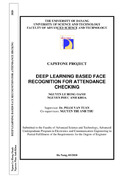
Vui lòng dùng định danh này để trích dẫn hoặc liên kết đến tài liệu này:
http://thuvienso.dut.udn.vn/handle/DUT/4117| Nhan đề: | Deep learning based face recognition for attendance checking | Tác giả: | Nguyen, Le Kieu Oanh Nguyen, Phuc Anh Khoa |
Từ khoá: | Face recognition;Deep learning | Năm xuất bản: | 2020 | Nhà xuất bản: | Trường Đại học Bách khoa - Đại học Đà Nẵng | Tóm tắt: | Being watched and/or monitored is a legitimate fear for many people. This is why facial recognition is slowly to be accepted and welcomed in society. One industry or field of work that would benefit the most out of facial recognition though, is that of attendance systems. The applications of Face Recognition Based Attendance System could be considered to be an important tool for various institutions such as school, college and university. Depend on the uniqueness of an individual is in his/her face. In this system, human face is used for marking the attendance automatically. Traditional checking attendance method requires calling outloud the name or roll number of students in order to record attendance. This process consumes a lot of time for a lecture that lasts about 60 minutes. To stay away from such losses, an automatic checking attendance process is used in this project which is based on Face Recognition technique. In this project, we built and set up a complete automatic attendance system including Face Recognition module and Web Application for management, and we also built a face dataset of students in the FAST department. In Face Recognition technique, facial detection and recognition was used. Face detection is used to locate the position of face region and face recognition is used for marking the understudy’s attendance. The dataset of students in the class is stored and when the face of an individual student matches with one of the faces stored in the dataset then his/her attendance is recorded. The major steps in our proposal recognition module are detecting the faces, aligning the face from cropped images, representing the face features by FaceNet model, classifying the features with Support Vector Machine. Four different face detection methods which are Haar-cascades, Histogram of Oriented Gradients and Support Vector, Convolutional Neural Networks, Multi- task Cascaded Convolutional Networks have been tested with the UTK face dataset for examining negative impacts of intensity of light and head pose problems. After face aligning by the Facial Landmark method, the FaceNet based on Convolutional Neural Network was used to extract representative features. The Support Vector Machine is then applied to train a recognizer on FaceScrub dataset. The obtained results show that the proposed Face Recognition system using Multi-task Cascaded Convolutional Networks and Alignment process by the Facial Landmark method leads to highest F1-score of 97%. Further analysis among examined algorithms and the structure to build the attendance system have been presented in this research thesis. |
Mô tả: | DA.FA.20.020 ; 62 p. |
Định danh: | http://thuvienso.dut.udn.vn/handle/DUT/4117 |
| Bộ sưu tập: | DA.Điện tử - Viễn thông |
Các tập tin trong tài liệu này:
| Tập tin | Mô tả | Kích thước | Định dạng | Đã có tài khoản, vui lòng Đăng nhập |
|---|---|---|---|---|
| 7.DA.FA.20.020.NguyenLeHongOanh.pdf | Thuyết minh | 12.24 MB | Adobe PDF |  |
Các đề xuất từ CORE
Lượt xem
2
đã cập nhật vào 26-11-2024
Lượt tải xuống 50
6
đã cập nhật vào 26-11-2024
Google Scholar TM
Kiểm tra...
Khi sử dụng các tài liệu trong Hệ thống quản lý thông tin nghiên cứu phải tuân thủ Luật bản quyền.